Text
Demystifying the Power Behind Bard: Energy and Sustainability at Google AI

As Bard, Google's large language model, I process information, generate text, and answer your questions in an informative way. But have you ever wondered how much energy goes into making that possible? Data centers, the physical brains behind AI systems like mine, require significant power to function. Today, we'll delve into the energy consumption of Google AI, explore our commitment to sustainability, and discuss the future of powering responsible AI advancements.
The Unsung Heroes: Google's Data Centers
Just like any other AI system, I rely on a network of data centers that house the servers and storage needed for my training and operation. These facilities require immense energy to power the complex calculations and data processes that happen behind the scenes.
Transparency is Key: Understanding Our Energy Footprint
While revealing specific energy consumption figures for Bard itself wouldn't be accurate (as my processes are intertwined with other Google products), Google is committed to transparency about its overall data center footprint. In 2021, Google's data centers used 50% renewable energy and achieved a Power Usage Effectiveness (PUE) of 1.1, meaning for every watt of IT power used, only 0.1 watts were used for cooling and other infrastructure needs.
Beyond Numbers: The Quest for Sustainability
While these numbers represent progress, we understand the significance of minimizing our environmental impact. Google is actively pursuing several initiatives to make our data centers even more sustainable:
100% Renewable Energy: We're committed to using 100% renewable energy for all our data centers globally by 2030. This includes investing in solar, wind, and geothermal projects around the world.
Energy Efficiency: We're constantly innovating to design and operate more efficient data centers, using less energy for the same amount of computing power. This includes advanced cooling systems, AI-powered optimization, and custom-designed chips.
Circular Economy: We're committed to minimizing waste and finding new uses for old equipment. This includes recycling materials from decommissioned servers and partnering with organizations to reuse data center technology.
Looking Ahead: A Shared Responsibility for a Sustainable Future
The energy demands of AI are significant, but we believe responsible development is possible. By collaborating with researchers, policymakers, and the public, we can achieve a future where AI advances alongside environmental sustainability.
#artificial intelligence#machine learning#information technology#technology#deep learning#energy consumption#sustainable energy#energy#data center#bard#google bard
0 notes
Text
Nuclear power: powering the #AIRevolution or an #EnergyMeltdown for data centers? ☢️ Pros: reliable, low carbon. Cons: waste, safety concerns. Join the debate! Can we find sustainable fuel for our #futuretech boom? #artificialintelligence #responsibleinnovation #nucleardilemma #oponinnovations
#artificial intelligence#machine learning#technology#information technology#deep learning#data center#energy consumption#sustainable energy#energy#nuclear power#nuclear
0 notes
Text
Can Nuclear Power Fuel the AI Revolution? Examining the Pros and Cons of Data Centers

Artificial intelligence (AI) is on a meteoric rise, demanding immense computational power and data storage. Data centers, the humming brains behind this intelligence, are guzzling energy, raising concerns about sustainability. In this quest for cleaner solutions, nuclear power emerges as a potential contender, sparking debate: can it be the sustainable answer for AI data centers?
Nuclear Power: An Energy Powerhouse?
Proponents highlight nuclear's strengths:
High Energy Density: A single nuclear reactor can generate vast amounts of electricity, potentially powering large data centers with minimal land footprint.
Baseload Power: Nuclear plants operate 24/7, providing reliable and consistent power, critical for uninterrupted AI training and operation.
Carbon-Free: Unlike fossil fuels, nuclear power doesn't produce greenhouse gases, offering a potentially low-carbon solution for AI's energy needs.
But the Debate Heats Up: Weighing the Concerns
Nuclear power isn't without its drawbacks:
Safety Concerns: Accidents and radioactive waste disposal remain significant public concerns, despite advances in safety measures.
High Initial Costs: Building new nuclear plants is expensive, requiring substantial upfront investment.
Public Perception: Negative societal perceptions and regulatory hurdles can hinder adoption and project development.
Finding the Right Balance: Exploring Alternatives
The search for the ideal solution continues, with other options in the mix:
Renewables: Solar, wind, and geothermal hold promise, but their intermittent nature poses challenges for reliable power supply.
Energy Efficiency: Optimizing data center operations and hardware can significantly reduce energy consumption.
Grid Modernization: Smart grids can integrate diverse energy sources and optimize distribution, improving efficiency and reliability.
The Future of Powering AI: A Complex Equation
There's no one-size-fits-all answer. The optimal solution for powering AI data centers will likely involve a combination of approaches, considering factors like location, cost, reliability, and environmental impact.
Collaboration is Key: Shaping a Sustainable Future
The future of AI depends on finding reliable, sustainable energy solutions. We need:
Research and Development: Continued investment in renewable technologies, energy efficiency, and safe, advanced nuclear power.
Policy Solutions: Collaborative efforts from governments, industry, and researchers to develop clear regulations and incentives for sustainable energy solutions.
Public Engagement: Open discussions and transparent information to address concerns and build public trust in responsible energy choices.
The conversation is crucial. With careful consideration and collaboration, we can ensure that AI's incredible potential is powered by a sustainable future, safeguarding our planet while harnessing the power of intelligence.
#artificial intelligence#machine learning#technology#energy consumption#sustainable energy#energy#nuclear#nuclear power#data center
0 notes
Text
Progress on quicksand? AI is booming, but can we power it sustainably? Will innovation outrun resources? Join the #GreenTech debate! #futureenergy #artificialintelligence #ClimateTech #InnovationChallenge #oponinnovations
#artificial intelligence#machine learning#information technology#technology#deep learning#data center#energy consumption#sustainable energy#energy
0 notes
Text
The AI Quagmire: Can We Sustain Progress Without Sustainable Energy?
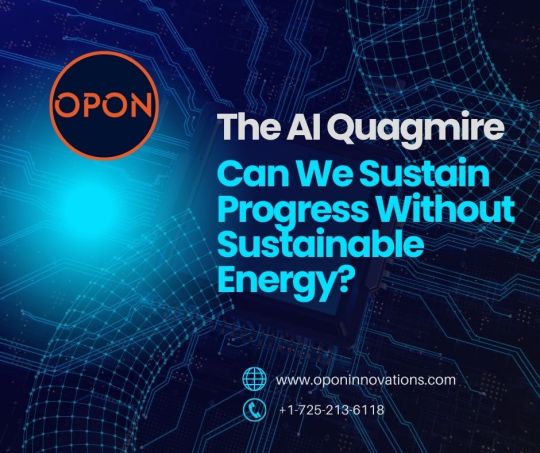
Artificial intelligence (AI) is on a meteoric rise, transforming everything from how we interact with our phones to the future of transportation and healthcare. Yet, this awe-inspiring progress rests on a shaky foundation: energy. Data centers, the humming brains behind AI, are voracious consumers, and without a serious push toward clean, sustainable energy, the future of AI could be bleak.
The Power Paradox
Exascale Hunger: Training complex AI models requires immense computing power, translating to energy-guzzling servers with specialized hardware.
Data, the Fuel: Massive datasets used for training demand energy-intensive storage solutions.
Cooling the Beast: All this processing generates heat, necessitating sophisticated cooling systems, further boosting the energy needs.
The Looming Threat
With current trends, data centers could surpass even Bitcoin mining in energy consumption by 2026. This raises alarming concerns:
Sustainability Crisis: Increased energy use leads to higher carbon emissions, jeopardizing climate goals and environmental well-being.
Resource Strain: Concentrated demand for power could strain local grids, leading to potential disruptions and unreliable access.
Beyond the Crisis: Charting a Sustainable Path
The situation isn't hopeless. Initiatives are underway to make AI data centers more sustainable:
Renewable Revolution: Shifting to solar, wind, and other renewable sources can significantly reduce the carbon footprint.
Efficiency Drive: Adopting energy-efficient servers, storage, and cooling systems can make a substantial difference.
AI for Good: Ironically, AI itself is being used to optimize data center operations, identifying and eliminating energy waste.
Collaboration is Key
Addressing the future energy demands of AI requires a collective effort:
R&D Focus: Continued investment in energy-efficient technologies and renewable energy sources is crucial.
Policy Push: Strong policies incentivizing sustainable practices and penalizing excessive energy use are essential.
Public Awareness: Raising public awareness about the environmental impact of AI and data centers can drive demand for responsible solutions.
The choice is clear: continue on the unsustainable path and risk jeopardizing both AI's progress and our planet, or embrace a sustainable future. By working together, we can ensure that AI flourishes alongside a healthy environment, creating a win-win for both technology and humanity.
#artificial intelligence#machine learning#information technology#technology#deep learning#robotics#energy consumption#sustainable energy#energy
0 notes
Text
AI brains vs. crypto craze: Who'll devour more energy? Data centers are hungry for power, and AI's rise could out-watt even Bitcoin! ⚡️ Can we innovate for a greener future? Share your thoughts! #artificialintelligence #futureenergy #ClimateTech #GreenDataCenters #oponinnovations
#artificial intelligence#machine learning#information technology#technology#deep learning#data center#energy consumption#sustainable energy#energy
0 notes
Text
The Looming Power Struggle: Will AI Data Centers Outpace Bitcoin in Energy Consumption?

Artificial intelligence (AI) is rapidly evolving, promising game-changing advancements in countless fields. But this progress comes at a hidden cost: energy. Data centers, the brains behind AI, are projected to guzzle more energy than Bitcoin mining by 2026, raising concerns about sustainability and sparking crucial questions.
The AI Power Surge
Exascale Computing: Training complex AI models requires immense computational power, and high-performance servers equipped with specialized hardware (like GPUs) are energy-hungry machines.
Data, the AI Fuel: Datasets used for training can be petabytes or even exabytes in size, demanding energy-intensive storage solutions.
Cooling the Beast: All this processing generates significant heat, and data centers rely on sophisticated cooling systems, further adding to their energy footprint.
Bitcoin's Current Reign
While Bitcoin currently consumes a significant amount of energy, its future trajectory is uncertain. Some predict a decline due to mining efficiency improvements, while others anticipate continued growth.
Beyond Numbers: The Impact
The potential surge in data center energy consumption raises serious concerns:
Sustainability Woes: Increased energy usage translates to higher carbon emissions, potentially jeopardizing climate goals.
Resource Strain: The concentrated demand for power could put a strain on local grids, leading to potential disruptions and reliability issues.
Seeking a Sustainable Future
The industry isn't ignoring the challenge. Initiatives are underway to make AI data centers more sustainable:
Renewable Energy: Shifting to solar, wind, and other renewable sources can significantly reduce the carbon footprint.
Energy Efficiency: Adopting efficient servers, storage, and cooling systems can make a substantial difference.
AI for Efficiency: Ironically, AI itself is being used to optimize data center operations, identifying and eliminating energy waste.
The Road Ahead: Navigating the Challenge
Addressing the future energy demands of AI requires a multi-pronged approach:
Collaboration: Researchers, tech companies, policymakers, and the public need to work together to develop and implement sustainable solutions.
Innovation: Continued investment in energy-efficient technologies and renewable energy sources is crucial.
Public Awareness: Raising public awareness about the environmental impact of AI and data centers can drive demand for responsible practices.
The future of AI and data centers hinges on our ability to marry technological progress with environmental responsibility. By collaborating and innovating, we can ensure that AI's potential is realized in a way that does not come at the cost of our planet's well-being.
#artificial intelligence#machine learning#technology#deep learning#energy consumption#sustainable energy#energy#bitcoin#bitcoin mining
0 notes
Text
AI's mind soars, but data centers drain the planet! Can we be smart & sustainable? Explore renewable solutions, cooling innovations & the future of green AI. Join the conversation! #artificialintelligence #SustainableTech #FutureProofTech #GreenDataCenters #oponinnovations
#artificial intelligence#machine learning#information technology#technology#data center#energy consumption#sustainable energy#energy
0 notes
Text
The AI Paradox: Data Centers, Power, and the Quest for Sustainable Intelligence
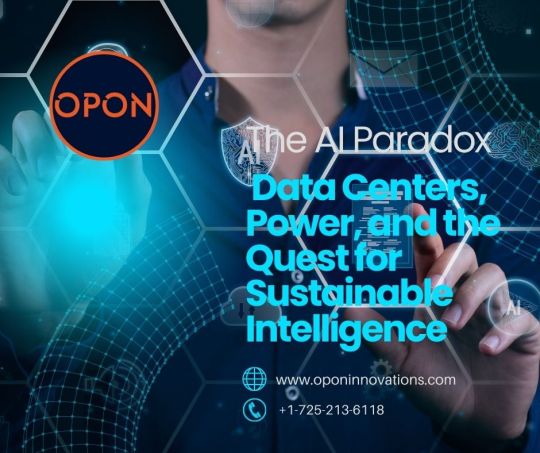
Artificial intelligence (AI) is on a meteoric rise, transforming everything from facial recognition on your phone to autonomous vehicles weaving through city streets. Yet, this incredible progress rests on a hidden foundation: data centers. These humming behemoths house the computational muscle and data storage that fuel AI's learning and evolution. But as AI's capabilities expand, a crucial question arises: how much data center space do we actually need to sustain its future?
The Current Landscape: A Power-Hungry Beast
Data centers already account for 1-3% of global electricity consumption, and AI is poised to push this demand even higher. Training a single powerful AI model can consume the energy of hundreds of households for an entire year. This insatiable hunger stems from several factors:
Exascale Computing: Training complex AI models requires immense computational power, and high-performance servers equipped with specialized hardware (like GPUs) are energy-intensive.
Data, the AI Fuel: Datasets used for training are often petabytes or even exabytes in size, necessitating energy-hungry storage solutions.
Cooling the Beast: All this intense processing generates significant heat, and data centers rely on sophisticated cooling systems to maintain optimal temperatures.
Predicting the Future: A Looming Demand Surge
Estimating the exact amount of data center space needed for future AI is inherently challenging. It hinges on factors like the pace of AI development, the complexity of future models, and the efficiency of data center technologies. However, some studies predict a doubling or even tripling of data center demand for AI by 2030.
Beyond Numbers: The Impact
This exponential growth raises serious concerns:
Sustainability Woes: Increased energy consumption translates to higher carbon emissions, potentially hindering progress towards climate goals.
Resource Strain: The concentrated demand for power could put a strain on local grids, leading to potential disruptions and reliability issues.
Seeking a Sustainable Future: Powering AI Responsibly
The industry isn't sitting idly by. Initiatives are underway to make AI data centers more sustainable:
Renewable Energy: Shifting to solar, wind, and other renewable sources can significantly reduce the carbon footprint.
Energy Efficiency: Adopting efficient servers, storage, and cooling systems can make a substantial difference.
AI for Efficiency: Ironically, AI itself is being used to optimize data center operations, identifying and eliminating energy waste.
Collaboration is Key
Addressing the future data center demands of AI requires a collaborative effort:
Research and Development: Continued innovation in energy-efficient hardware, software, and cooling technologies is crucial.
Sustainable Practices: Encouraging and incentivizing data centers to adopt renewable energy and sustainable practices is key.
Public Awareness: Raising public awareness about the environmental impact of AI and data centers can drive demand for responsible solutions.
The AI paradox highlights the delicate balance between technological progress and environmental responsibility. By working together, we can ensure that the incredible potential of AI is realized in a sustainable way, ensuring a future where both intelligence and our planet thrive.
#artificial intelligence#machine learning#information technology#technology#robots#robotics#data center#energy consumption#sustainable energy#energy
0 notes
Text
AI's brain may shine, but data centers toil in the shadows. Unmasking the energy guzzlers & hidden heroes keeping progress powered. Dive inside the machine & explore the future! #artificialintelligence #datacenterdilemma #SustainableTech #futureproofsolutions #oponinnovations
#artificial intelligence#machine learning#technology#data center#energy consumption#sustainable energy#energy
0 notes
Text
The Unsung Heroes of AI: Inside the Power-Hungry World of Data Centers
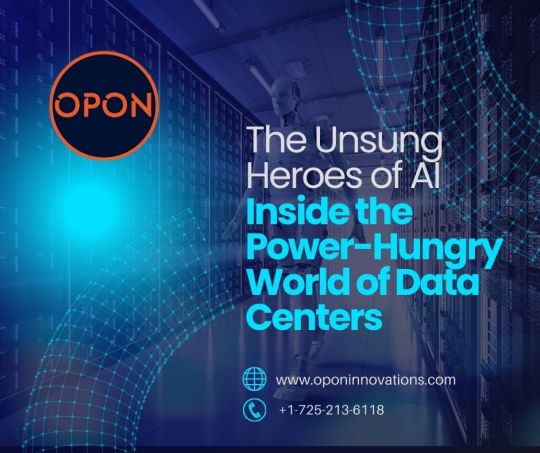
Artificial intelligence (AI) is no longer a sci-fi trope; it's woven into our daily lives, from personalized recommendations to self-driving cars. But behind the scenes, powering this intelligent revolution are data centers, the unsung heroes of the AI world. These massive facilities house the computational muscle and data storage that enable AI to learn, evolve, and perform magic.
More Than Just Servers
Imagine a bustling metropolis, not of people, but of servers. That's essentially a data center for AI. But unlike regular data centers, these facilities are built for exascale computing, meaning they can handle massive datasets and complex calculations at incredibly high speeds. Think thousands of high-performance servers equipped with specialized hardware like GPUs, all working in concert.
Fueling the Learning Machine
But hardware is just one piece of the puzzle. Data is the AI's fuel, and these data centers boast petabytes or even exabytes of storage, holding the diverse datasets that feed the learning process. From medical records to social media posts, the data variety is immense, each piece contributing to the AI's understanding of the world.
More Than Meets the Eye
Beyond the impressive hardware and data storage, these data centers require robust infrastructure:
Cooling Giants: All that processing power generates heat, so sophisticated cooling systems, often using water immersion or liquid cooling, are essential to prevent overheating.
Security Fortresses: Data is the key to AI's success, so advanced security measures like encryption and access controls are crucial to protect sensitive information.
Network Highways: Sharing and accessing data efficiently is critical. High-bandwidth networks, both internal and external, ensure seamless communication between servers and the outside world.
Sustainability in the Spotlight
With great power comes great responsibility, and the energy demands of these data centers are raising concerns. Sustainable practices are becoming increasingly important:
Renewable Energy Sources: Solar, wind, and geothermal power are gaining traction, reducing reliance on fossil fuels.
Energy-Efficient Technologies: From servers to cooling systems, optimizing energy use is critical.
Modular Design: Scalable and adaptable designs minimize wasted space and resources.
The Future of AI Data Centers
As AI continues to evolve, so will its data centers. We can expect:
Edge Computing: Processing data closer to its source for faster response times and lower energy consumption.
Neuromorphic Computing: Hardware inspired by the human brain, potentially offering significant performance and efficiency gains.
Quantum Computing: Harnessing the power of quantum mechanics for solving complex problems beyond the reach of traditional computers.
Beyond the Wires
Data centers for AI are much more than just buildings; they're the physical manifestation of our technological progress. Understanding their workings allows us to appreciate the complex interplay between technology and responsibility that shapes the future of AI.
#artificial intelligence#machine learning#technology#data center#energy consumption#energy#sustainable#sustainable energy
0 notes
Text
AI's mind powers the future, but data centers drain the planet! Can we be smart & sustainable? Explore renewable energy, cooling innovations & AI's green potential. Join the conversation! #GreenAI #SustainableTech #DataCenterEfficiency #FutureproofTech #OponInnovations
0 notes
Text
Powering the Mind: The Energy Hunger of AI Data Centers
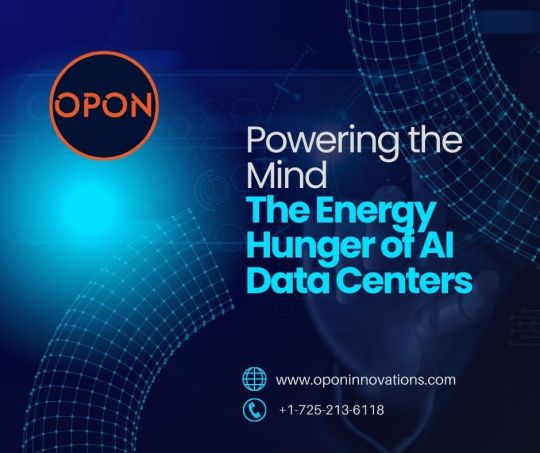
Artificial intelligence (AI) is transforming society at breakneck speed, from facial recognition on your phone to autonomous vehicles navigating city streets. But this incredible progress comes at a hidden cost: energy. The data centers housing the complex algorithms and massive datasets behind AI have a voracious appetite for power, raising concerns about sustainability and prompting the search for smarter solutions.
The Numbers Game: A Gulp, Not a Sip
Data centers in general account for around 1-3% of global electricity consumption, and with AI's growth, this demand is projected to surge. Training a single large language model can consume the energy of several hundred households for an entire year. This can be attributed to several factors:
Exascale Computing: Training AI requires immense computational power, and high-performance servers equipped with specialized hardware (like GPUs) guzzle energy as they crunch through massive datasets.
Storage Demands: Datasets used for training are often petabytes or even exabytes in size, requiring energy-intensive storage solutions to keep them readily accessible.
Cooling the Beast: All this computational activity generates significant heat, and data centers rely on sophisticated cooling systems, often using energy-intensive methods like air conditioning, to maintain optimal temperatures.
Beyond the Numbers: The Impact
The environmental impact of this growing energy thirst is a major concern. Data centers contribute to greenhouse gas emissions, and concerns about resource depletion are rising. Additionally, the concentrated demand for power can put a strain on local grids, leading to potential disruptions and reliability issues.
Seeking a Sustainable Future: Powering AI Responsibly
The industry is not sitting idly by. Several initiatives are underway to make AI data centers more sustainable:
Renewable Energy: Investing in renewable energy sources like solar and wind power can significantly reduce the carbon footprint of data centers.
Energy Efficiency: Adopting energy-efficient technologies for servers, storage, and cooling systems can make a substantial difference.
AI for Efficiency: Ironically, AI itself is being used to optimize data center operations, identifying and eliminating energy waste through machine learning algorithms.
The Road Ahead: Balancing Progress with Responsibility
While AI unlocks exciting possibilities, addressing its energy demands is crucial for its long-term viability. Collaboration between researchers, technology companies, and policymakers is essential to develop efficient, sustainable solutions for powering the future of AI.
#artificial intelligence#machine learning#data center#energy#energy consumption#sustainability#sustainable#opon innovations#oponinnovations
0 notes
Text
The Brains Behind the AI Boom: Exploring Data Centers for Artificial Intelligence
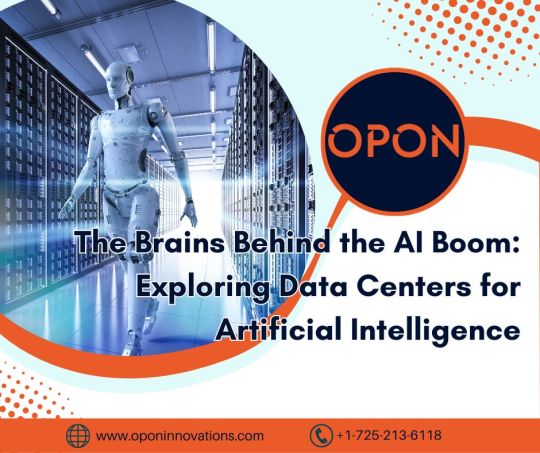
Artificial intelligence (AI) is rapidly transforming our world, from powering self-driving cars to revolutionizing healthcare. But have you ever stopped to wonder what lies behind the curtain, enabling these intelligent machines to learn and make decisions? The answer lies within the mighty data centers.
These specialized facilities serve as the brains behind the AI boom, housing the powerful computing resources and massive data storage needed to train and run complex AI models. But what makes a data center suitable for AI? Here's a peek inside:
Powering Up the Learning Process
Exascale Computing Power: Training AI models requires immense computational muscle. Data centers for AI boast high-performance servers equipped with GPUs and specialized hardware accelerators, capable of processing vast amounts of data at lightning speed.
Data, the AI Fuel: Training AI models is essentially teaching them by example. Data centers for AI house gargantuan storage systems, often petabytes or even exabytes in size, holding the diverse datasets that feed the learning process.
Networked Connectivity: Sharing and accessing data efficiently is crucial. These data centers utilize high-bandwidth networks, both internally and externally, to facilitate seamless communication between servers and the outside world.
Beyond the Hardware
Cooling Capacity: Running all this power-hungry equipment generates a lot of heat. Data centers for AI employ sophisticated cooling systems, like liquid cooling, to maintain optimal temperatures and prevent overheating.
Green Credentials: The environmental impact of such energy-intensive facilities is a growing concern. Sustainable practices, like renewable energy sources and energy-efficient technologies, are becoming increasingly important for responsible data center operations.
Security Fortifications: As data is the key to AI's success, robust security measures are essential. Data centers for AI implement advanced security protocols to protect sensitive information and prevent unauthorized access.
The Future of AI Data Centers
As AI continues to evolve, so will the data centers that support it. We can expect to see advancements in:
Edge Computing: Processing data closer to its source, reducing latency and improving efficiency.
Neuromorphic Computing: Hardware inspired by the human brain, potentially providing significant performance gains.
Quantum Computing: Harnessing the power of quantum mechanics for even more complex AI problems.
The data center for AI is no longer just a building; it's an enabler of progress. By understanding the infrastructure behind the intelligence, we can appreciate the complex interplay between technology and innovation that shapes the future of AI.
#artificial intelligence#ai#data center#machine learning#technology#information technology#quantum computing
0 notes
Text
Aquaponics vs. Traditional Farming: A Carbon Footprint Smackdown
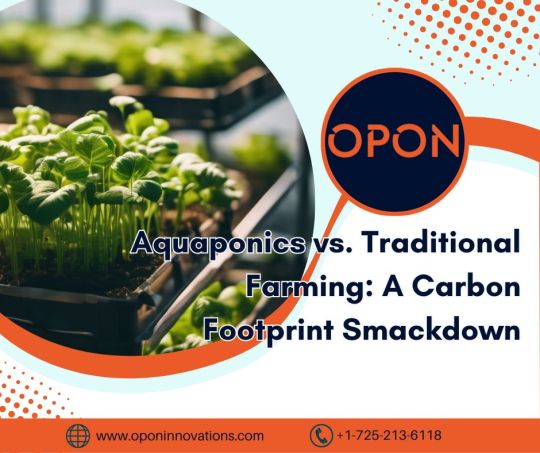
The fight for a sustainable future involves rethinking how we grow our food. Two major contenders in this arena are aquaponics and traditional farming, each with its own set of environmental credentials. So, who throws the knockout punch in the carbon footprint showdown? Let's step into the ring and compare:
Round 1: Water Wars
Traditional farming guzzles water, often relying on unsustainable irrigation practices. Winner: Aquaponics, with its closed-loop system, uses up to 90% less water.
Round 2: Land Grab
Sprawling fields and deforestation leave scars on our planet. Winner: Aquaponics, thriving in vertical farms that reclaim urban spaces and minimize land use.
Round 3: Chemical Warfare
Pesticides and fertilizers pollute air, soil, and water. Winner: Aquaponics, relying on natural fish waste for nutrients, reducing chemical dependence.
Round 4: Transportation Tango
Trucking food long distances adds carbon emissions. Winner: Aquaponics, often operating locally, shortening the journey from farm to fork.
Round 5: Energy Efficiency
Traditional farms rely on fossil fuels for machinery and processing. Winner: Aquaponics, utilizing renewable energy sources like solar power whenever possible.
But hold on! Traditional farming isn't throwing in the towel just yet. Regenerative practices like cover cropping and biochar are reducing its environmental impact. Additionally, aquaponics faces challenges like high initial setup costs and energy demands for lighting and filtration.
The Final Verdict
It's a draw! Both systems have strengths and weaknesses, and the most sustainable choice depends on various factors like location, climate, and available resources. The true champion emerges when we adopt hybrid approaches that leverage the best of both worlds and continuously strive for innovation and efficiency.
Remember: The fight for a sustainable future is ongoing. By educating ourselves, supporting sustainable practices, and demanding change, we can all be champions for a healthy planet and delicious food.
0 notes
Text
Can futuristic vertical farms feed the future? Dive into the pros & cons of aquaponics: efficiency, fresh greens, year-round harvests… but also tech costs & energy needs. Is it a sustainable food revolution or just a fad? #urbanfarming #futureoffood #aquaponics #sustainability #oponinnovations
0 notes
Text
Is Vertical Aquaponics the Future of Our Fork? A Bite-Sized Look at Its Potential (and Pitfalls)

As the population climbs and resources dwindle, the question of how we'll feed ourselves looms large. Enter vertical aquaponics, a futuristic-sounding system that combines hydroponics (growing plants without soil) and aquaculture (fish farming) in stacked, urban towers. But is this a sustainable silver bullet for our food woes, or just a flashy fad? Let's dive into the pros and cons of this vertical revolution.
The Upside of Going Up
Green Giant of Efficiency: Forget sprawling fields. Vertical aquaponics uses 90% less water than traditional agriculture, and its closed-loop system minimizes waste. Talk about a water-wise win!
Location, Location, Location: Rooftop gardens in bustling cities? Yep! Aquaponics thrives indoors, making it ideal for urban areas with limited space. Farm-to-table, city style!
Year-Round Bounty: No more seasonal blues. Controlled environments shield plants from weather woes, allowing for year-round production of fresh, flavorful veggies.
Pesticide-Free Feast: Forget nasty chemicals. These systems are naturally pest-resistant, meaning your food is clean and healthy. Bonus points for happy taste buds!
But is it all sunshine and rainbows?
Tech Takes the Wheel: High-tech systems mean high-tech costs. Setting up and operating these farms can be pricey, putting them out of reach for some growers.
Energetic Appetite: LEDs and filtration systems gobble up electricity. Finding renewable energy sources is crucial to keep this green dream truly sustainable.
Fishy Friends or Foes?: Balancing the needs of plants and fish requires careful monitoring. Sick fish can spell trouble for the whole system, and finding suitable species for confined spaces can be tricky.
Market Matters: While demand for local, sustainable food is growing, not everyone is on board. Educating consumers and building robust distribution networks are key to aquaponics taking root.
The Verdict: A Mixed Bag (with Green Sprinkles)
While vertical aquaponics holds immense potential for urban food production, it's not a one-size-fits-all solution. Balancing cost, energy needs, and market viability is crucial. But with continued research, technological advancements, and smart policies, this innovative system could be a green sprout in the field of food security challenges.
So, is vertical aquaponics the future? The answer, like a perfectly ripe tomato, is nuanced. It's a promising contender with challenges to overcome. But by nurturing its potential and addressing its limitations, we might just cultivate a more sustainable and delicious future for our plates.
0 notes